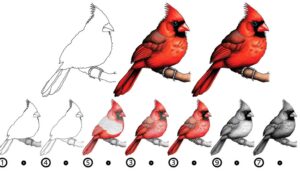What Bird Looks Like a Cardinal but Is Not?
Several bird species bear a resemblance to cardinals, primarily due to their striking red plumage. The Scarlet Tanager, with its brilliant red coloration, is often confused with cardinals, especially males.
The Summer Tanager presents an all-red appearance in males, making it another common misidentification. The Pyrrhuloxia, found in arid regions of the southwestern U.S., also exhibits a cardinal-like profile but has a distinct call.
The Red Crossbill's sexual dimorphism and irruptive migratory behavior provide another point of confusion. Each of these species displays unique characteristics that distinguish them from cardinals, offering more insight into their identification.

Key Takeaways
- Scarlet Tanager males have bright red plumage similar to cardinals but prefer deciduous forests and migrate long distances.
- Summer Tanager males are vibrant red and feed on insects, often mistaken for Northern Cardinals.
- Pyrrhuloxia, with red accents, inhabits arid regions, has a diet of seeds and insects, and nests in shrubs.
- Vermilion Flycatcher sports vivid red plumage, known for agile insect-catching in open habitats.
- Hepatic Tanager males feature warm reddish-brown plumage, distinguishable by their thicker, shorter bill compared to cardinals.
Scarlet Tanager
The Scarlet Tanager (Piranga olivacea) is often mistaken for a cardinal due to its vivid red plumage and distinctive black wings and tail. This passerine bird, native to North America, exhibits marked sexual dimorphism: males display the characteristic bright red and black, while females are olive-yellow with darker wings.
During migration, they traverse approximately 6,000 kilometers between North American breeding grounds and South American wintering habitats. Data from the North American Breeding Bird Survey indicate a stable population trend, with an estimated 2.2 million individuals.
Habitat preference includes deciduous forests, where they forage primarily on insects and fruit. Vocalizations are a series of melodious phrases, often compared to a hoarser version of the American Robin's song.
Vermilion Flycatcher
Exhibiting a remarkably vivid red plumage, the Vermilion Flycatcher (Pyrocephalus obscurus) is a small passerine bird known for its agile aerial insect-catching behavior.
Measuring approximately 13-14 cm in length, males display a brilliant red crown and underparts, contrasting with dark brown wings and tail. Females, in contrast, exhibit a more subdued coloration with a peachy belly and brownish upperparts.
Mainly found in open habitats such as savannas, scrublands, and agricultural fields, their range extends from the southwestern United States to South America.
Characterized by their distinctive foraging strategy, Vermilion Flycatchers frequently perch conspicuously before launching into the air to capture insects mid-flight.
This species plays a vital role in controlling insect populations within its ecosystem.
Summer Tanager
Renowned for its striking all-red plumage in males, the Summer Tanager (Piranga rubra) is a medium-sized songbird prevalent in deciduous forests across the southeastern United States during the breeding season.
Females and juveniles exhibit a more subdued yellow-green coloration. This species is often mistaken for the Northern Cardinal due to its vivid coloration and similar size, measuring approximately 17 cm in length with a wingspan of 28-30 cm.
The Summer Tanager primarily feeds on insects, particularly bees and wasps, which it captures mid-flight. Its vocalizations, characterized by a series of clear, melodic whistles, are a distinguishing feature.
Migration patterns show a southward movement to Central and South America during the non-breeding season.
Pyrrhuloxia
Pyrrhuloxia (Cardinalis sinuatus), often referred to as the desert cardinal, inhabits arid regions of the southwestern United States and northern Mexico, distinguished by its sturdy bill and grayish plumage with red accents. This species exhibits sexual dimorphism, with males displaying more vivid red highlights than females. Their diet primarily includes seeds and insects, adapted to survive in harsh, xeric environments.
| Feature | Description |
|---|---|
| Habitat | Arid regions, Southwestern U.S., Northern Mexico |
| Plumage | Grayish with red accents |
| Bill | Robust and parrot-like |
The Pyrrhuloxia's call is a series of sharp, metallic notes, which differs significantly from the Northern Cardinal. Their nesting habits involve constructing cup-shaped nests in thorny shrubs, ensuring protection from predators.
Red Crossbill
The Red Crossbill (Loxia curvirostra) is characterized by its unique crossed bill, which enables it to expertly extract seeds from conifer cones, a primary component of its diet.
This specialized morphology allows the Red Crossbill to thrive in coniferous forests, particularly where spruce, pine, and fir trees are abundant.
Morphometric analyses reveal sexual dimorphism, with males typically exhibiting brighter red plumage compared to the more subdued tones in females.
According to avian population studies, Red Crossbills exhibit irruptive migration patterns, moving in response to fluctuating cone crops.
Vocalization analysis has identified multiple call types, suggesting cryptic species within what is currently recognized as a single species.
This adaptability and ecological specificity make the Red Crossbill a fascinating subject for ornithological research.
Rose-breasted Grosbeak
The Rose-breasted Grosbeak (Pheucticus ludovicianus) exhibits a distinctive color pattern with males showcasing a striking rose-red breast, contrasting sharply with black and white plumage, while females present more subdued brown and streaky appearances.
This species inhabits deciduous forests and woodlands across North America, with migratory patterns extending from Canada to northern South America.
Its diet mainly consists of insects, seeds, and fruits, and it displays notable foraging behaviors such as gleaning and hovering.
Distinctive Color Patterns
Characterized by its striking black and white plumage with a vivid rose-red patch on its breast, the Rose-breasted Grosbeak (Pheucticus ludovicianus) exhibits distinctive color patterns that differentiate it from other species.
Adult males present a stark contrast between their jet-black head, wings, and back, and their white underparts, accentuated by the conspicuous rose-red patch that extends from the throat to the upper chest.
Females and immature males display more subdued coloration, with brown and white streaked plumage, and lack the rose-red patch. Additionally, both genders feature prominent white wing bars and a large, pale bill, enhancing species identification.
These detailed observations underscore the unique color morphology of the Rose-breasted Grosbeak, facilitating accurate field identification.
Habitat and Range
Inhabiting deciduous and mixed woodlands across North America, the Rose-breasted Grosbeak's range extends from southern Canada through the eastern and central United States, reaching as far south as northern South America during winter migration.
Preferentially occupying habitats with dense foliage, these birds thrive in secondary forests, wood edges, and riparian corridors. Elevation-wise, they are found from sea level up to 3,000 feet.
Breeding territories are typically selected based on availability of food resources and nesting sites, resulting in high densities in regions with abundant berry-producing shrubs and tall trees. During migration, individuals traverse diverse ecosystems, covering approximately 2,500 miles.
Data indicates that climate change and habitat fragmentation could impact their migratory patterns and breeding success.
Diet and Behavior
Rose-breasted Grosbeaks exhibit an omnivorous diet, primarily consuming a diverse array of insects, seeds, and fruits, which they forage in their preferred dense foliage habitats.
Their insectivorous diet includes beetles, caterpillars, and grasshoppers, accounting for approximately 52% of their diet during the breeding season. Seeds and fruits, such as berries and tree buds, comprise the remaining 48%, providing essential nutrients and energy.
Behaviorally, these birds are known for their methodical foraging techniques, often observed meticulously picking food from leaves and branches. Males display territorial aggression, especially during the breeding season, using their distinct melodic song as an auditory marker.
Rose-breasted Grosbeaks also exhibit biparental care, with both sexes participating in nest building and chick rearing.
Hepatic Tanager
The Hepatic Tanager, Piranga flava, exhibits distinctive coloration traits with males showcasing a rich, reddish-brown hue, while females display olive-yellow plumage, often leading to confusion with the Northern Cardinal.
Habitat preferences include open pine-oak woodlands and montane forests, mainly in the southwestern United States and extending into Central America.
Data indicates a range from elevations of 1,500 to 3,000 meters, highlighting adaptability to various altitudinal zones.
Distinctive Coloration Traits
Exhibiting a warm reddish-brown plumage, the Hepatic Tanager (Piranga flava) presents distinct coloration traits that differentiate it from the more vividly red Northern Cardinal. Adult males exhibit a brick-red head and underparts, shifting to olive-brown on the back and wings, a coloration that serves as a key identification marker.
Females and juveniles are characterized by a more subdued yellowish-orange hue with olive-brown wings and tails. Detailed observations reveal that the species lacks the sharp contrast seen in Cardinals, showing a more uniform and muted tone across its body.
Additionally, the Hepatic Tanager's bill is thicker and shorter, complementing its unique color palette and providing a reliable means of visual differentiation.
Habitat and Range
Hepatic Tanagers (Piranga flava) are mainly found in subtropical and tropical humid forests, ranging from the southwestern United States through Central America to northern Argentina. This species inhabits elevations from sea level up to 3,000 meters, favoring broadleaf woodlands and pine-oak forests.
Studies indicate a preference for undisturbed habitats, though they adapt to secondary growth areas. Regional populations exhibit partial migratory behavior; northern populations migrate to Mexico and Central America during winter months.
Data shows nesting typically occurs at mid-canopy levels, utilizing dense foliage for concealment. Territories range from 2 to 5 hectares, depending on resource availability. Conservation status remains stable, yet habitat fragmentation poses a potential long-term risk, necessitating ongoing monitoring and habitat preservation efforts.
Conclusion
To sum up, the avian species often mistaken for the Northern Cardinal—Scarlet Tanager, Vermilion Flycatcher, Summer Tanager, Pyrrhuloxia, Red Crossbill, Rose-breasted Grosbeak, and Hepatic Tanager—exhibit remarkable morphological similarities yet possess distinct ecological niches and behavioral traits.
These species, with their vibrant plumage and unique song patterns, contribute to the rich tapestry of avian biodiversity.
The Scarlet Tanager's fiery red feathers, for example, could be likened to the flames of a thousand suns, enchanting birdwatchers and ornithologists alike.






